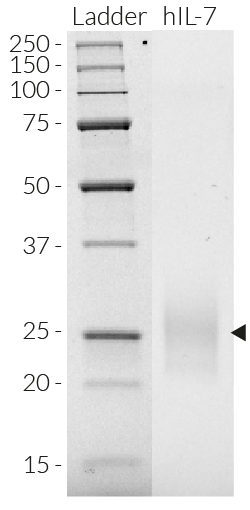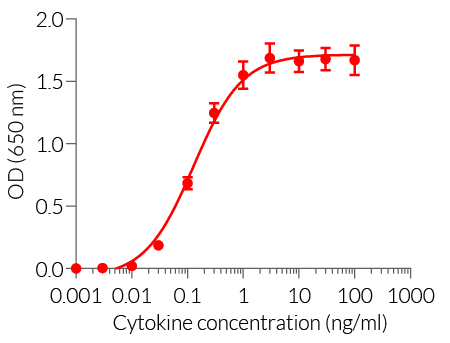Recombinant human IL-7 protein - Bioactive cytokine
| Product | Unit size | Cat. code | Docs. | Qty. | Price | |
|---|---|---|---|---|---|---|
|
Recombinant human IL-7 Recombinant cytokine, source: CHO |
Show product |
10 µg 2 x 25 µg |
rcyc-hil7
|
|
Human IL-7 protein - Mammalian cell-expressed, tag-free, carrier-free
Recombinant human IL-7 is a high-quality and biologically active cytokine, validated using proprietary IL-7 reporter cells. This T-cell-mediating cytokine of the γc superfamily is produced in CHO cells to ensure protein glycosylation and bona fide 3D structure.
Recombinant human IL-7 can be used together with HEK-Blue™ IL-7 cells for the screening of inhibitory molecules, targeting the cytokine and not the IL-7 receptor (see figures).
Key features
- Each lot is validated using HEK-Blue™ IL-7 cells
- Endotoxin ≤ 0.1 EU/µg
- 0.2 µm sterile-filtered
InvivoGen also offers:
Applications
- T cell and NK cell activation and propagation
- IL-7 detection and quantification assays (positive control)
- Screening and release assays for antibodies blocking IL-7 signaling
- Screening and release assays for engineered IL-7 proteins
Interleukin 7 (IL-7) is a hematopoietic growth factor that is critical for T and B cell differentiation, proliferation, and survival. It is extensively studied as an adjuvant for cancer vaccines and for its role in CAR T cell expansion. IL-7 has also been described in a variety of applications, such as T cell activation, T cell priming, and differentiation.
InvivoGen’s products are for research use only, and not for clinical or veterinary use.
Back to the topSpecifications
Source: Chinese hamster ovary (CHO) cells
Species: Human
Alternative name: IL7, Interleukin-7, Lymphopoietin 1 (LP-1), pre-B cell factor
Carrier: Carrier-free
Tag: Tag-free
Accession number: P13232
Protein size: 157 a.a. (D26-H177)
Molecular weight: ~ 17.5 kDa (predicted), 21-27 kDa (SDS-PAGE)
Solubility: 100 μg/ml in water
Formulation: 20 mM sodium phosphate, 150 mM NaCl, and 5% saccharose buffer solution (pH 7)
Sterility: 0.2 μm filtration
Form: Lyophilized
Reconstitution buffer: Endotoxin-free water (provided)
Purity: ≥ 95 % (SDS-PAGE)
Endotoxin: The absence of bacterial contamination (e.g. lipoproteins and endotoxins) has been confirmed using HEK-Blue™ TLR2 and HEK‑Blue™ TLR4 cells.
International Units (IU): > 1 x 108 IU/mg
Note: Please refer to the corresponding Certificate of Analysis (CoA) for the exact value. Each lot is tested with the reference standard for human IL-7 (NIBSC code 90/530) for reproducible cell culture conditions without the need for time-consuming lot-to-lot testing.
Tested applications: Cellular assays
Quality control: Each lot is functionally tested and validated
Back to the topContents
Recombinant human IL-7 is provided lyophilized and is available in two quantities:
- rcyc-hil7: 10 µg
- rcyc-hil7-5: 50 µg (2 x 25 µg)
Each product is provided with endotoxin-free water:
- 1.5 ml endotoxin-free water for rcyc-hil7
- 2 x 1.5 ml endotoxin-free water for rcyc-hil7-5
![]() Recombinant human IL-7 is shipped at room temperature.
Recombinant human IL-7 is shipped at room temperature.
![]() Upon receipt, it should be stored at -20°C.
Upon receipt, it should be stored at -20°C.
![]() Avoid repeated freeze-thaw cycles.
Avoid repeated freeze-thaw cycles.
Details
Interleukin 7 Signaling
Interleukin 7 (IL-7) is a secreted cytokine that plays an essential role in B cell and T cell development and function [1]. IL-7 signals through the heterodimeric cell surface IL-7 receptor (IL-7R) consisting of IL-7Rα (also called CD127) and IL-2Rγ (also called the common γ-chain or CD132). The binding of IL-7 to its receptor triggers three main signaling pathways: JAK/STAT, PI3K, and MAPK/ERK [1‑3]. Of note, IL-7R-mediated signaling triggers proliferative and anti‑apoptotic signals mainly by activating the JAK/STAT pathway [1-3]. IL-7/IL-7R signaling, which regulates lymphocyte growth and survival, has been implicated in the development of malignancies and autoimmune diseases [1-4].
IL-7 therapeutic targeting
The IL-7 cytokine, together with IL-2 and IL-15, is currently under investigation for application in ex vivo T cell expansion. These cytokines are used in different concentrations and combinations to improve cell viability, proliferation, and differentiation in CAR T cell culture [5]. Given the pleiotropic and robust biological effects of IL-7, especially its role in the survival, development, proliferation, and even maintenance of memory of T cells, several research teams apply IL-7 as a molecular adjuvant to strengthen the immunogenicity of cancer vaccines, as well as to maintain a long-term memory response against cancers [6].
References:
1. Lin J. et al., 2017. The role of IL-7 in Immunity and Cancer. Anticancer Res. 37(3):963-7.
2. Ribeir D. et al., 2018. STAT5 is essential for IL-7-mediated viability, growth, and proliferation of T-cell acute lymphoblastic leukemia cells. Blood Adv. 2(17):2199-213.
3. Mackall C.L. et al., 2011. Harnessing the biology of IL-7 for therapeutic application. Nat Rev Immunol. 11(5):330-42.
4. Barata J.T. et al., 2019. Flip the coin: IL-7 and IL-7R in health and disease. Nat Immunol. 20(12):1584-93.
5. Sudarsanam H, et al., 2022. Influence of Culture Conditions on Ex Vivo Expansion of T Lymphocytes and Their Function for Therapy: Current Insights and Open Questions. Front Bioeng Biotechnol.;10:886637
6. Zhao Y, et al., 2022. IL-7: A promising adjuvant ensuring effective T cell responses and memory in combination with cancer vaccines? Front Immunol.;13:1022808.








